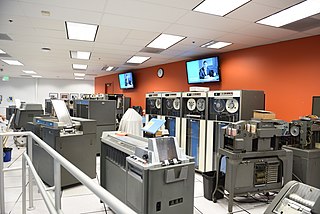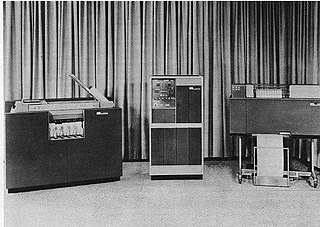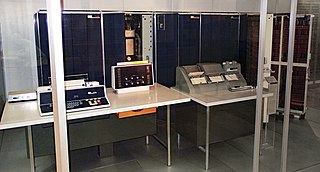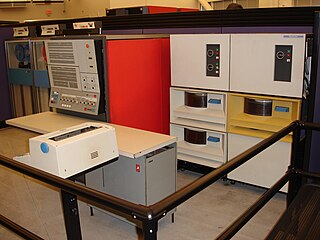
The IBM System/360 (S/360) is a family of mainframe computer systems that was announced by IBM on April 7, 1964, and delivered between 1965 and 1978. It was the first family of computers designed to cover both commercial and scientific applications and a complete range of applications from small to large. The design distinguished between architecture and implementation, allowing IBM to release a suite of compatible designs at different prices. All but the only partially compatible Model 44 and the most expensive systems use microcode to implement the instruction set, featuring 8-bit byte addressing and fixed point binary, fixed point decimal and hexadecimal floating-point calculations.

The IBM 1401 is a variable-wordlength decimal computer that was announced by IBM on October 5, 1959. The first member of the highly successful IBM 1400 series, it was aimed at replacing unit record equipment for processing data stored on punched cards and at providing peripheral services for larger computers. The 1401 is considered by IBM to be the Ford Model-T of the computer industry due to its mass appeal. Over 12,000 units were produced and many were leased or resold after they were replaced with newer technology. The 1401 was withdrawn on February 8, 1971.

CP-67 is a hypervisor, or Virtual Machine Monitor, from IBM for its System/360 Model 67 computer.
Disk Operating System/360, also DOS/360, or simply DOS, is the discontinued first member of a sequence of operating systems for IBM System/360, System/370 and later mainframes. It was announced by IBM on the last day of 1964, and it was first delivered in June 1966. In its time, DOS/360 was the most widely used operating system in the world.
IBM manufactured magnetic disk storage devices from 1956 to 2003, when it sold its hard disk drive business to Hitachi. Both the hard disk drive (HDD) and floppy disk drive (FDD) were invented by IBM and as such IBM's employees were responsible for many of the innovations in these products and their technologies. The basic mechanical arrangement of hard disk drives has not changed since the IBM 1301. Disk drive performance and characteristics are measured by the same standards now as they were in the 1950s. Few products in history have enjoyed such spectacular declines in cost and physical size along with equally dramatic improvements in capacity and performance.

The IBM System/3 was an IBM midrange computer introduced in 1969, and marketed until 1985. It was produced by IBM Rochester in Minnesota as a low-end business computer aimed at smaller organizations that still used IBM 1400 series computers or unit record equipment. The first member of what IBM refers to as their "midrange" line, it also introduced the RPG II programming language. It is the first ancestor in the product line whose current version is the IBM i series and includes the highly successful AS/400.

The IBM 1400 series are second-generation (transistor) mid-range business decimal computers that IBM marketed in the early 1960s. The computers were offered to replace tabulating machines like the IBM 407. The 1400-series machines stored information in magnetic cores as variable-length character strings separated on the left by a special bit, called a "wordmark," and on the right by a "record mark." Arithmetic was performed digit-by-digit. Input and output support included punched card, magnetic tape, and high-speed line printers. Disk storage was also available.

The Honeywell 200 was a character-oriented two-address commercial computer introduced by Honeywell in December 1963, the basis of later models in Honeywell 200 Series, including 1200, 1250, 2200, 3200, 4200 and others, and the character processor of the Honeywell 8200 (1968).

IBM 7070 is a decimal-architecture intermediate data-processing system that was introduced by IBM in 1958. It was part of the IBM 700/7000 series, and was based on discrete transistors rather than the vacuum tubes of the 1950s. It was the company's first transistorized stored-program computer.

The IBM System/360 Model 30 was a low-end member of the IBM System/360 family. It was announced on April 7, 1964, shipped in 1965, and withdrawn on October 7, 1977. The Model 30 was designed by IBM's General Systems Division in Endicott, New York, and manufactured in Endicott and other IBM manufacturing sites outside of U.S.
Count key data (CKD) is a direct-access storage device (DASD) data recording format introduced in 1964, by IBM with its IBM System/360 and still being emulated on IBM mainframes. It is a self-defining format with each data record represented by a Count Area that identifies the record and provides the number of bytes in an optional Key Area and an optional Data Area. This is in contrast to devices using fixed sector size or a separate format track.

The IBM 2821 Control Unit attaches card readers and card punches, and line printers to the IBM System/360 and IBM System/370 families of computers. The devices attached may be a combination of:

The IBM System/360 Model 20 is the smallest member of the IBM System/360 family announced in November 1964. The Model 20 supports only a subset of the System/360 instruction set, with binary numbers limited to 16 bits and no floating point. In later years it would have been classified as a 16-bit minicomputer rather than a mainframe, but the term "minicomputer" was not current, and in any case IBM wanted to emphasize the compatibility of the Model 20 rather than its differences from the rest of the System/360 line. It does, however, have the full System/360 decimal instruction set, that allows for addition, subtraction, product, and dividend of up to 31 decimal digits.
Attached Support Processor (ASP) was an implementation of loosely coupled multiprocessing for IBM's OS/360 operating system. IBM later changed the name to Asymmetrical multiProcessor but retained the acronym ASP.

The IBM System/360 Model 50 is a member of the IBM System/360 family of computers. The Model 50 was announced in April 1964 with the other initial models of the family, and first shipped in August 1965 to the Bank of America.

The IBM System/360 Model 85 is a high-end member of the System/360 family of computers, with many advanced features, and was announced in January 1968 and first shipped in December 1969. IBM built only about 30 360/85 systems because of "a recession in progress".

The IBM System/370 Model 135 was announced March 8, 1971, the only 370 introduced that year. The 135 was IBM's fifth System 370, and it was withdrawn October 16, 1979.

The IBM 303X is a discontinued line of mainframe computers, the first model of which, the IBM 3033 Processor, nicknamed "The Big One", was introduced March 25, 1977.

The IBM System/370 Model 115 was announced March 13, 1973, at that time the low-end model of the System/370 line. It was promoted as "an ideal System/370 entry system for users of IBM's System/3, 1130 computing system and System/360 Models 20, 22 and 25."














